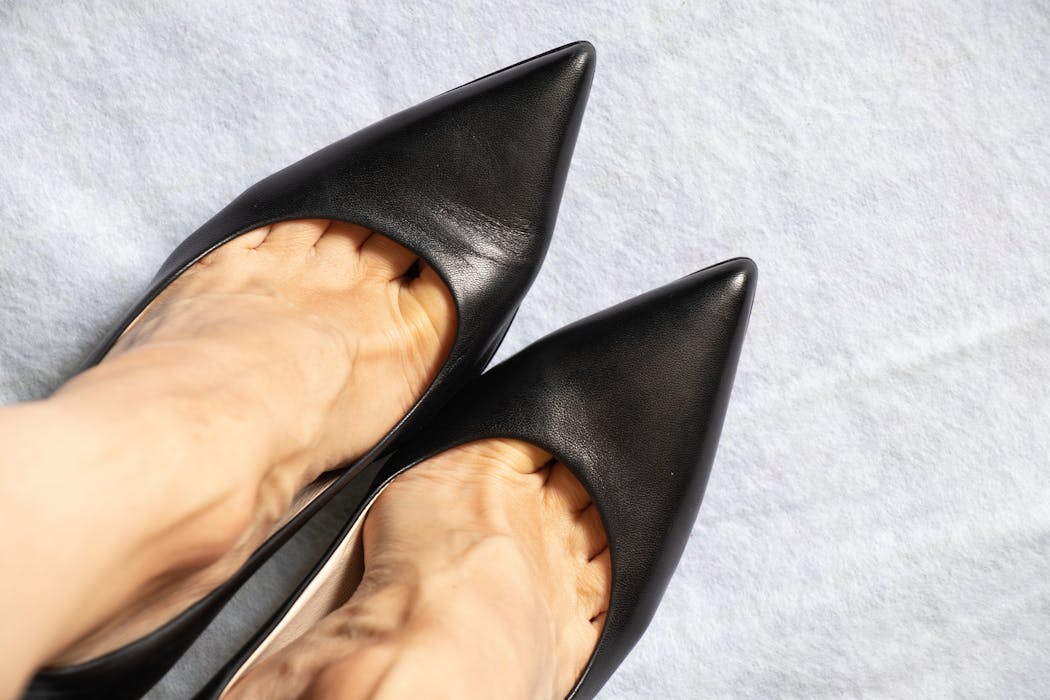Why are women’s shoes so pointy? A fashion expert on impractical but stylish footwear
- Written by Michael Watson, Interim Associate Chair and Instructor of Retailing, University of South Carolina

Like most items of fashion, shoes signal the wearer’s status[10] to their peers. Poulaines were heavily decorated and expensive to make, and their elongated design made it difficult to move around. Thus, wearing poulaines communicated to others that the wearer was wealthy, having no need to perform physical work that required mobility.
Pointy shoes as status symbol
These shoes became so popular that in 1463 King Edward IV of England passed laws limiting toe length[11] to 2 inches for anyone below a lord in social ranking. This decree had social, political and religious effects.
Socially, restricting the longest-toed shoes to the nobility ensured the shoe would be a visual status marker associated with the upper classes. This obvious sign helped maintain social order and prevented lower-class people from trying to pass themselves off as higher in standing than they were.
Politically, the king used this same legislation to control the textile trade and protect English industries[12]. By regulating the fabrics and accessories necessary to make excessively ornate shoes, Edward IV could limit foreign competition with English textile manufacturers and at the same time manage fashion trends.
From a religious perspective[14], King Edward IV passed these laws on the grounds that God was displeased by anything other than modest clothing – for the lower classes, anyway. Additionally, religious leaders believed that the long toes prevented people from kneeling in a respectful, submissive manner and so restricted the ability to properly pray[15].
The pressure to literally “fit in” to these pointy shoes also came with a physical cost. Poulaines hurt the wearer’s feet and could make their toe bones crooked. Bunions – a bony bump that develops on the inside of the foot at the big toe – became more common[16] with the popularity of these shoes.
Pain with a purpose
Various cultures have adopted pointy shoes throughout history, often to signify status, wealth or a connection to a specific subculture. A few examples include the juttis or khussas[17] of Northern India and Pakistan, respectively; the lotus shoes[18] once popular in China; and the pointed flat slippers[19] worn during the Etruscan civilization.
From a practical standpoint, however, pointy-toed shoes can lead to foot deformities[20] and health problems[21]. Why do people still wear pointy shoes if they’re so painful?
One reason is a desire to belong. Your brain is programmed to seek out and find people[24] who think and believe like you. Like how early humans needed to stay with their tribe to survive, your brain thinks that being part of a group can help keep you safe.
Because high-heeled, pointed shoes are commonly worn by women, wearing them gives the wearer feelings of acceptance from other women. While there is nothing inherent[25] about pointy shoes that make them feminine or attractive – considering that they were often originally designed for men – fashion often relies on trends that people unconsciously agree on. What is stylish is often influenced by accepted social norms.
Your brain also has clever shortcuts[26] to help you make decisions quickly. One shortcut is to look at what other people are doing[27]. If you see lots of people wearing a certain style or playing a particular game, your brain thinks, well, if everyone is doing this, it must be a good choice. This process helps you make decisions without having to think too hard about every little detail.
Scientists call the powerful, mental influence fashion has on both the person wearing it and the people seeing their outfit enclothed cognition[28]. The shoes you wear may alter how you perceive yourself and others, as well as carry symbolic meaning. So designers might use elongated shoes to create the illusion of a long, slender silhouette to create a look that is not only seen but also personally felt as elegant and powerful.
With new technology and an increased consumer desire for comfort[29], the good news is that next time you get dressed and want to wear pointy, fashionable shoes, they may be at least a little less painful than they were in the past.
Hello, curious kids! Do you have a question you’d like an expert to answer? Ask an adult to send your question to CuriousKidsUS@theconversation.com[30]. Please tell us your name, age and the city where you live.
And since curiosity has no age limit – adults, let us know what you’re wondering, too. We won’t be able to answer every question, but we will do our best.
References
- ^ Curious Kids (theconversation.com)
- ^ CuriousKidsUS@theconversation.com (theconversation.com)
- ^ uncomfortable to wear (www.pointelles.com)
- ^ over two decades in the fashion industry (sc.edu)
- ^ initially adopted by men (businessday.ng)
- ^ poulaines – or cracows (fashionhistory.fitnyc.edu)
- ^ stuff the ends of the shoes (www.londonmuseum.org.uk)
- ^ Deutsches Schuhmuseum Hauenstein (nat.museum-digital.de)
- ^ CC BY-SA (creativecommons.org)
- ^ signal the wearer’s status (www.atlasobscura.com)
- ^ laws limiting toe length (www.bbc.com)
- ^ control the textile trade and protect English industries (boydellandbrewer.com)
- ^ Loyset Liédet (circa 1470)/Bibliothèque de l'Arsenal (commons.wikimedia.org)
- ^ religious perspective (www.britannica.com)
- ^ ability to properly pray (www.londonmuseum.org.uk)
- ^ became more common (theconversation.com)
- ^ juttis or khussas (artsandculture.google.com)
- ^ lotus shoes (www.ucpress.edu)
- ^ pointed flat slippers (doi.org)
- ^ foot deformities (doi.org)
- ^ health problems (doi.org)
- ^ Daniel Schwen/The Children's Museum of Indianapolis via Wikimedia Commons (en.wikipedia.org)
- ^ CC BY-SA (creativecommons.org)
- ^ seek out and find people (theconversation.com)
- ^ nothing inherent (www.businessoffashion.com)
- ^ clever shortcuts (theconversation.com)
- ^ look at what other people are doing (theconversation.com)
- ^ enclothed cognition (doi.org)
- ^ consumer desire for comfort (www.simon-kucher.com)
- ^ CuriousKidsUS@theconversation.com (theconversation.com)
Authors: Michael Watson, Interim Associate Chair and Instructor of Retailing, University of South Carolina

